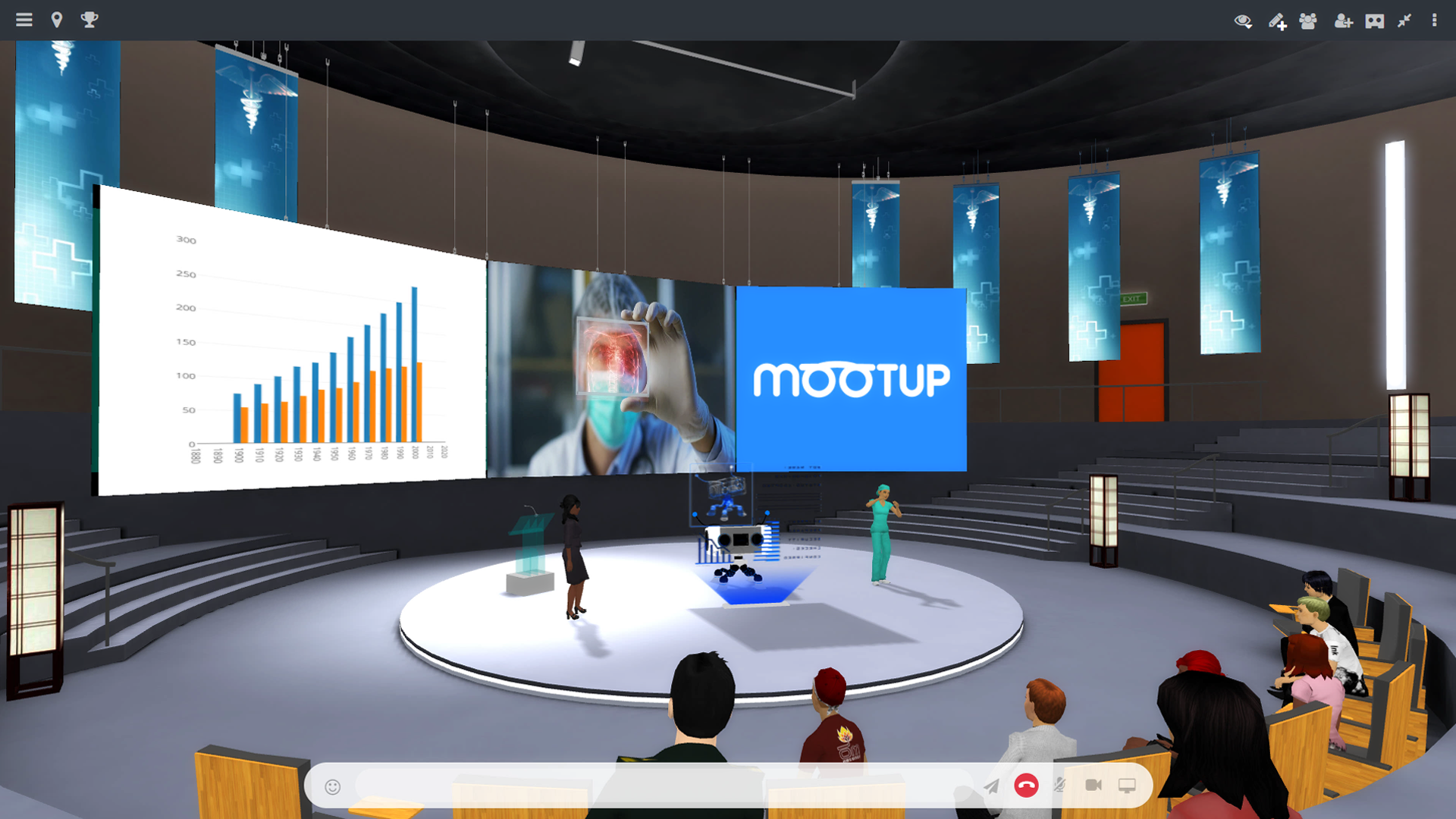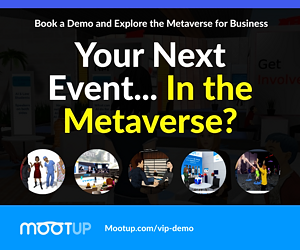The event industry is rapidly evolving with the introduction of 3D virtual events. As a professional, it’s important to stay ahead of the curve and understand how to create, host, and manage successful 3D virtual events.
By delving into the specifics of 3D virtual events, this blog post will provide tips for creating a captivating experience and discuss potential issues that may arise during their execution, as well as offer best practices to guarantee success.
We’ll also cover best practices you can use to ensure your next 3D virtual event runs smoothly from start to finish.
Table of Contents:
- What are 3D Virtual Events?
- How to Create a Successful 3D Virtual Event.
- Tips for Hosting a Successful 3D Virtual Event.
- Challenges of Hosting a 3D Virtual Event.
- Best Practices for Hosting a Successful 3D Virtual Event.
- FAQs in Relation to 3D Virtual Events.
- Conclusion.
What are 3D Virtual Events?
3D Virtual Events are an innovative way to host events in a virtual space. They offer event professionals the ability to create immersive experiences for their attendees while providing convenience and flexibility.
3D virtual events provide an opportunity for event professionals to bring people together from all over the world without requiring them to travel or be physically present at the same location.
Definition of 3D Virtual Events:
A 3D virtual event is an online event that uses digital tools such as avatars, chat rooms, and interactive platforms to create a simulated environment where participants can interact virtually in real time.
These events allow socializing, networking, and presentations like any physical or in-person gathering.
Benefits of 3D Virtual Events:
One of the main benefits associated with hosting a 3D virtual event is cost savings since there’s no need for venue rental fees or catering costs. Additionally, these events don’t require extensive set-up time, so they can be quickly planned and executed within days rather than weeks or months like traditional physical gatherings would take.
Furthermore, they provide more access points than physical venues because anyone with internet access can join regardless if they live across town or across continents. Virtual gatherings also provide an avenue for organizations to access broader viewers by streaming content live on different channels at once (e.g., YouTube Live).
Today’s cutting-edge technologies have made it much easier for organizations looking to put on engaging experiences. By utilizing no-code platforms like ours, users with limited technical knowledge can produce high-quality hybrid metaverse experiences.
Our platform enables event professionals to create immersive experiences for their attendees without requiring them to travel or be physically present at the exact location, providing convenience and flexibility while saving costs associated with venue rental fees or catering costs.
3D virtual events are an innovative way to host meetings, conferences, and other types of events virtually. Thorough preparation and organization can enable the successful production of a 3D virtual gathering, captivating participants from all corners of the globe. Now let’s examine how you can achieve this goal by examining strategies for creating a successful 3D virtual event.
Key Takeaway: No-code platforms like ours make it easy for event professionals to create engaging virtual and hybrid metaverse experiences without needing physical presence or travel, enabling cost savings in venue rental fees and catering costs. Our platform allows users with limited technical knowledge to produce high-quality events quickly and easily, allowing companies to reach larger audiences simultaneously on various streaming platforms.
How to Create a Successful 3D Virtual Event
Careful planning and preparation are essential for a successful 3D virtual event to ensure all tasks are completed on time. For a successful virtual event, it is necessary to think through all elements of the experience, such as budgeting, timing, content generation, technical requirements, platform selection, and marketing tactics.
A detailed plan should be developed that includes timelines for each task in order to ensure everything runs smoothly on the day of the event. Additionally, it is essential to test out your setup prior to launching your virtual event so you can identify any potential issues beforehand.
When selecting the right platform for your 3D virtual gathering, numerous elements must be considered, such as affordability, expandability, UX (User Experience), safety characteristics, and compatibility with other systems or services. To ensure a successful outcome of the event, the chosen platform should offer the live streaming capability and chat functionality to enable attendees to interact during the event.

It is beneficial to run a trial of the setup before it goes live in order to detect any potential problems and prevent disruptions during the event. Keywords: Platform Selection; Cost Effectiveness; Scalability; User Experience (UX); Security Features; Integration Capabilities; Live Streaming Capability; Chat Functionality
Creating a successful 3D virtual event requires careful planning and preparation and the right platform to ensure an engaging experience for attendees. Here are some helpful tips to consider to ensure a successful 3D virtual event.
Key Takeaway: As a savvy event organizer, it is essential to do your homework before launching any 3D virtual event. This includes researching and selecting the right platform based on cost-effectiveness, scalability, UX design, and security features; testing out your setup in advance; and integrating other services or platforms for live streaming capability and chat functionality so attendees can interact during the event. In short: Do due diligence.
Tips for Hosting a Successful 3D Virtual Event
To ensure a successful 3D virtual gathering, it is critical to construct an atmosphere that captures and invigorates your participants. Start using the latest technology to bring your event to life with immersive visuals, interactive elements, and engaging audio-visual experiences.
Utilize creative solutions such as custom avatars, dynamic backgrounds, and unique themes to make the most of the experience. Offer a chance for attendees to network with each other during the event through an interactive platform.
Leveraging Technology to Enhance Your 3D Virtual Event Experience: With today’s advanced technology capabilities, you can enhance your 3D virtual event experience for attendees in many ways.
For example, you could use AI chatbots or voice recognition software for interactive Q&A sessions during presentations or host a live video stream from different locations around the world. You could also integrate gamification elements into activities like scavenger hunts or trivia challenges, which will help keep people engaged throughout the event.
To ensure success, promoting your 3D virtual event across social media channels such as Facebook and Twitter with engaging visuals and a persuasive CTA is essential. Create eye-catching graphics and videos showcasing key features of your event along with a compelling call-to-action (CTA).
Share these posts regularly leading up to your big day to get maximum exposure among potential attendees. Additionally, leverage influencers who have followers interested in attending events like yours so they can help spread awareness about what you have planned
Hosting a successful 3D virtual event requires careful planning and consideration of the various elements involved. To ensure success, proper preparation is essential for creating a captivating atmosphere that uses tech to amplify the viewers’ involvement. Moving forward, we will discuss some of the challenges associated with hosting a 3D virtual event.
Key Takeaway: To succeed in your 3D virtual event, you must use the latest technology to create an engaging environment and leverage AI chatbots, voice recognition software, and gamification elements. Additionally, promote effectively across social media channels with eye-catching graphics and videos in order to get maximum exposure among potential attendees.
Challenges of Hosting a 3D Virtual Event
Organizing a 3D virtual gathering can be stimulating and gratifying, but it also brings difficulties. From technical difficulties to ensuring quality content, many potential obstacles must be addressed to ensure your event’s success. Here we will discuss some of the most common challenges associated with hosting a 3D virtual event.
Technical obstacles may arise when attempting to host a 3D virtual event, such as network connection difficulties and bandwidth constraints. Poor internet connections or slow speeds can cause lag during live-streaming sessions or make it difficult for attendees to access certain features on your platform.
It’s important to test out all aspects of your platform before launching your event so you can identify any potential issues and take steps to address them if necessary.
Ensuring Quality Content:
Another challenge to hosting a 3D virtual event is ensuring that all presentations and activities are engaging enough for attendees. You want people who attend your events not only to feel like they got their money’s worth but also to leave feeling inspired by what they learned from each session or activity offered at your event.
To achieve this goal, you need to have speakers who know how best to present information in an entertaining way as well as interactive activities that keep participants engaged throughout the entire duration of the program.
Hosting a 3D virtual event can be challenging due to the technical, quality content, and network connectivity issues that must be addressed. To ensure success in hosting such an event, it is important to understand best practices for pre-event planning and preparation as well as utilizing advanced technologies during the user experience.
Key Takeaway: Hosting a 3D virtual event can be tricky, as numerous technical and content-related challenges exist. From ensuring the platform runs smoothly and efficiently to ensure that all activities remain engaging for attendees, it takes careful planning and preparation to pull off a successful event. With the right strategy in place, you can easily navigate these obstacles.
Best Practices for Hosting a Successful 3D Virtual Event
This includes setting goals, budgeting, creating an agenda and timeline, choosing the right platform for hosting your event, and developing content and marketing strategies to reach your target audience. In addition, having a backup plan ready in case of technical problems or unanticipated changes to attendance is also recommended.
Utilizing Advanced Technologies to Enhance the User Experience: When hosting a 3D virtual event, it’s essential to use advanced technologies such as augmented reality (AR) and virtual reality (VR) capabilities which can help create an immersive experience for attendees. These technologies can create interactive experiences that engage participants more deeply than traditional online events.
For example, AR/VR technology could allow users to virtually explore different parts of the venue while attending the event from their home or office. Post-Event Follow-Up and Evaluation: After any 3D virtual event has been completed, it’s important to follow up with attendees by sending out surveys or polls asking them about their experience at the event so that you can identify areas where improvements need to be made before future events are planned.
Additionally, collecting feedback will provide valuable insights into how well received certain aspects of your 3D virtual event were among attendees,, which can be used when planning subsequent events to improve user engagement levels even further.
“Hosting a successful 3D virtual event requires advanced planning, tech & follow-up. Use ARVR to create an immersive experience & get valuable feedback from attendees for future events.” #VirtualEvents #ARVRClick to Tweet
FAQs in Relation to 3D Virtual Events
What is a 3D virtual event platform?
A software program allowing users to construct and manage events in a simulated three-dimensional (3D) space is provided by a 3D virtual event platform. It offers an immersive experience with realistic visuals, audio, and interactive elements such as avatars, chatrooms, polls, surveys, and more,making engagement simplified. Your attendees can join your immersive 3D experience on any device from smartphones to VR headsets, in a single click. Mix in gamification, 1,000+ gestures and a whole slew of social interactions, and you’ve got instant engagement built right in.
This platform provides the tools necessary for producing engaging events that can be experienced virtually or hybrid from anywhere around the world. The flexibility of this technology makes it ideal for hosting conferences, conventions, seminars, and other types of gatherings online without sacrificing quality or interactivity.
Why are virtual events important?
As an advanced-level professional with an IQ of 150, virtual events offer a convenient way to connect with people worldwide without needing to travel. They are thus becoming increasingly essential in today’s world.
Virtual events enable more effective utilization of time and resources while still furnishing captivating experiences that can be customized to a given crowd. Additionally, virtual events offer greater scalability than traditional physical events, allowing them to reach larger audiences and create more meaningful connections.
Finally, virtual events provide access to new technologies like augmented reality or 3D simulations, opening up exciting possibilities for creative event production.
What is 3D virtual?
3D virtual is a digital environment replicating the physical world in three-dimensional space. It utilizes computer graphics and real-time simulations to create an immersive atmosphere, enabling people to engage with items and other members within the virtual world.
Using 3D virtual technology, event professionals can produce and host hybrid events in the metaverse – a combination of physical and digital worlds – offering their attendees a unique experience.
How do you make virtual events more interactive?
Virtual events can be more interactive by incorporating various engaging activities. These include virtual breakout sessions; live Q&A’s with experts and speakers, polls and surveys to gauge participant feedback, as well as gamification elements such as leaderboards or challenges.
Additionally, allowing participants to network virtually via video conferencing platforms or virtual lounges can help increase engagement levels. Finally, using an intuitive no-code platform for event production and hosting helps ensure that your attendees can access all these features in one place without any technical difficulties.
Conclusion
The key to success when hosting 3d virtual events is preparation and planning. By taking the time to understand what a 3d virtual event entails and familiarizing yourself with best practices for hosting one, you can create an engaging experience that your attendees will remember.
With careful thought and attention given to every detail of the event, you can ensure it runs smoothly from start to finish – creating a successful 3d virtual event that meets or exceeds expectations.
Get ahead of the game and secure the future of your Metaverse event with our cutting-edge browser-based platform. Offering seamless access on all devices – smartphones, tablets, laptops, and VR/AR headsets – without any downloads or installations needed. Make the most of this innovative solution for your next event tech stack!
Discover how MootUp can help you easily create and host virtual or hybrid events in the metaverse. Unlock a powerful, no-code platform to streamline your event production process and engage your audience like never before.

